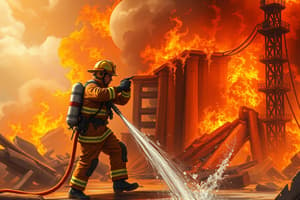Podcast
Questions and Answers
Which action is MOST crucial for preserving a ship's damage control capabilities?
Which action is MOST crucial for preserving a ship's damage control capabilities?
- Maintaining the watertight integrity of the ship. (correct)
- Stockpiling extra rations and medical supplies.
- Upgrading the ship's communication systems.
- Training personnel in advanced navigation techniques.
What is the PRIMARY function of the main drainage system on a ship?
What is the PRIMARY function of the main drainage system on a ship?
- Removing large quantities of water from compartments quickly. (correct)
- Distributing fuel to the ship's engines.
- Providing potable water to the crew.
- Sprinkling water for fire suppression.
In damage control, how is the fuel and freshwater system utilized to manage a ship's condition?
In damage control, how is the fuel and freshwater system utilized to manage a ship's condition?
- To rapidly cool down overheated machinery.
- To provide an emergency source of power.
- To control list and trim by shifting tank contents. (correct)
- To extinguish electrical fires with non-conductive fluids.
Why are ships divided into compartments as a damage control strategy?
Why are ships divided into compartments as a damage control strategy?
What is the PRIMARY purpose of a collision bulkhead?
What is the PRIMARY purpose of a collision bulkhead?
Why do watertight doors on a ship typically have multiple dogs?
Why do watertight doors on a ship typically have multiple dogs?
What is the main function of gaskets on watertight doors and hatches?
What is the main function of gaskets on watertight doors and hatches?
What is the purpose of the knife-edge feature on watertight doors and hatches?
What is the purpose of the knife-edge feature on watertight doors and hatches?
Which of the following is a critical maintenance practice for gaskets on watertight doors and hatches?
Which of the following is a critical maintenance practice for gaskets on watertight doors and hatches?
What role do 'dogs' play in ensuring the watertight integrity of a ship's compartments?
What role do 'dogs' play in ensuring the watertight integrity of a ship's compartments?
In the context of damage control, what's a significant difference between watertight and non-watertight doors?
In the context of damage control, what's a significant difference between watertight and non-watertight doors?
If a ship's engine room is flooding, under what circumstances might the main condenser circulatory pumps be used?
If a ship's engine room is flooding, under what circumstances might the main condenser circulatory pumps be used?
What characterizes a secondary drainage system in comparison to the main drainage system?
What characterizes a secondary drainage system in comparison to the main drainage system?
How does the fire main system support damage control efforts on a ship?
How does the fire main system support damage control efforts on a ship?
Which of the following features is MOST characteristic of a watertight bulkhead?
Which of the following features is MOST characteristic of a watertight bulkhead?
Where is the bow collision bulkhead typically located on a ship?
Where is the bow collision bulkhead typically located on a ship?
What is a key difference in the construction of non-watertight doors compared to watertight doors?
What is a key difference in the construction of non-watertight doors compared to watertight doors?
What are hatches primarily used for on a ship?
What are hatches primarily used for on a ship?
What might be a consequence of NOT maintaining the watertight integrity of a ship?
What might be a consequence of NOT maintaining the watertight integrity of a ship?
How might shifting the contents of the fuel and fresh water tanks help in damage control?
How might shifting the contents of the fuel and fresh water tanks help in damage control?
Flashcards
Damage Control
Damage Control
A procedure to minimize the harmful effects of damage to a ship.
Damage Control Objectives
Damage Control Objectives
Maintaining watertight integrity, making rapid repairs, and preserving stability.
Damage Control Systems
Damage Control Systems
Drainage, fire main, and fuel/fresh water systems.
Drainage System
Drainage System
Signup and view all the flashcards
Flooding System
Flooding System
Signup and view all the flashcards
Types of Drainage Systems
Types of Drainage Systems
Signup and view all the flashcards
Main Drainage System
Main Drainage System
Signup and view all the flashcards
Secondary Drainage System
Secondary Drainage System
Signup and view all the flashcards
Main Condenser Circulatory Pumps
Main Condenser Circulatory Pumps
Signup and view all the flashcards
Fire Main System
Fire Main System
Signup and view all the flashcards
Fuel/Fresh Water System
Fuel/Fresh Water System
Signup and view all the flashcards
Purpose of Compartments
Purpose of Compartments
Signup and view all the flashcards
Bulkhead
Bulkhead
Signup and view all the flashcards
Watertight Bulkhead
Watertight Bulkhead
Signup and view all the flashcards
Collision Bulkhead
Collision Bulkhead
Signup and view all the flashcards
Watertight Doors
Watertight Doors
Signup and view all the flashcards
Non-Watertight Doors
Non-Watertight Doors
Signup and view all the flashcards
Hatches
Hatches
Signup and view all the flashcards
Gasket
Gasket
Signup and view all the flashcards
Pins
Pins
Signup and view all the flashcards
Study Notes
- Damage control is a procedure to reduce the harmful effects of impairment to a ship.
- The objectives of damage control are to:
- Preserve the watertight integrity of the ship
- Make rapid repairs to damaged gear and structures
- Maintain the stability and maneuverability of the ship
Damage Control Systems
- There are several damage control systems including:
- Drainage and flooding systems
- Fire main and sprinkling systems
- Fuel and fresh water systems
Drainage and Flooding
- Drainage is used for:
- Removing large quantities of water from compartments
- Removing water from the hull under normal operating conditions
- Flooding is used for:
- Flooding compartments to balance the ship
- There are three principal types of drainage systems:
- Main drainage system: High capacity, uses piping and pumps to move large quantities of water quickly
- Secondary drainage system: Drains smaller compartments forward and aft of the main drainage system
- Main condenser circulatory pumps: Can be used for emergency drainage of the engine room
Fire Main System
- The fire main system is made up of piping, pumps, plugs, valves, and controls.
- It is designed to supply plenty of water for firefighting.
Fuel and Fresh Water System
- The fuel and fresh water system consists of tanks, filling lines, and feed lines.
- It is important in damage control because the list and trim of the ship can be partially controlled by shifting the contents of the tanks.
Watertight Integrity
- Damage control depends on the proper utilization of watertight integrity features.
- Ships are divided into compartments for the purpose of:
- Controlling flooding
- Segregating activities of personnel
- Providing underwater protection via tanks and voids
Bulkheads
- A bulkhead is a transverse or longitudinal partition that separates compartments.
- A watertight bulkhead:
- Is made of heavier metal than an ordinary bulkhead
- Is mostly unpierced except for watertight doors, piping, or wiring
- A collision bulkhead:
- Is designed to protect from flooding throughout the ship
- The bow collision bulkhead is the first transverse bulkhead aft of the stern
- The last transverse bulkhead aft is the collision bulkhead that protects the after part of the ship
Doors and Hatches
- Doors and Hatches are enclosures for bulkhead openings.
- They are constructed to be as structurally strong as the bulkhead where they are installed.
- Watertight doors:
- Are used in watertight bulkheads on the second deck and below
- Are designed to resist 1 ½ times as much pressure as the bulkhead they service
- Have 6 to 12 dogs for securing
- Non-watertight doors:
- Are used on non-watertight bulkheads
- Usually have fewer dogs than watertight doors, made of dogs which require individual protection
- Hatches:
- Horizontal doors used for access through decks
Closure Fittings and Gaskets
- Gaskets:
- Are made of rubber and installed on doors and hatches
- Close against knife edges to form a watertight and airtight seal
- Must be kept free of dirt and grease
- Knife edges:
- Built out from decks and bulkheads
- Gaskets on watertight doors and hatches close on knife edges
- Dogs and Pins
- Pins are used to connect dogs to the deck or bulkheads
- Dogs are used to make closures
Studying That Suits You
Use AI to generate personalized quizzes and flashcards to suit your learning preferences.




